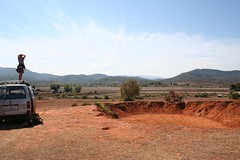(Formerly Mush and Stub's World Tour) - Travel tips, advice and adventure stories from our World Travels since 2001. Over 65 countries and counting. Click on the links at each entry to see more photos in Flickr.
Monday, February 13, 2006
Bomb Crater, Phonsavan, Laos
Today we learnt a lot about Laos. During the Vietnam War more bombs and mines were dropped by the Americans on Laos than that dropped on Germany in the whole of the Second World War. In what was known as the 'Secret War' because it was ordered against the Geneva Convention and un-beknownst to the US public, Laos became a major target. In addition, bombs that had been destined for Vietnam but were never dropped for whatever reason, were then dropped on Laos: US airplanes were not allowed to land back at base in neutral Thailand with armed 'ordnance' (as bombs are called) on board. In Laos two provinces were hard hit -and about 90% of the land there was covered by ordnance. About 60% of these are still unexploded bombs and mines. Deaths still occur and clearing the area is a long process. MAG - Mines Advisory Group is an English group that send out experts into the field - the mine field, literally!, to detect and defuse bombs and mines. They also recruit and encourage the Lao people to learn how to detect and defuse bombs too. Out and about, we saw lots of bomb craters, and we had to be very careful where we walked, following the guide or coloured markers on the ground. We saw live, unexploded bombs lying around too - which is kind of scary. To clear these takes money and time and as a result cluster bombs are just left out in the open. They have a huge program in schools to teach kids not to touch or play with 'bombies' at the locals call them but still... Later that day, we visited some Hmong Tribal villages, and they have some creative uses for the many bomb casings found in the countryside. Building supports, herb gardens, fences, fire pits to name a few. Lunch at a beautiful waterfall, before sneaking to the local poppy field where they harvest the milk to make opium. They actually put a slice in the seed pod in which the milk flows out, then re-slice again beside it making a nice pattern on the pod. I had no idea, but now know what to be cautious of! * Mush
Subscribe to:
Post Comments (Atom)




1 comment:
That was a very cool batch of picts.
Post a Comment